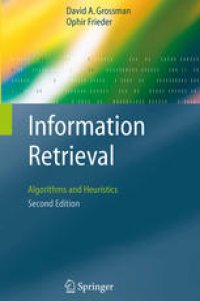
Ebook: Information Retrieval: Algorithms and Heuristics
- Tags: Computer Science general, Data Storage Representation, Information Storage and Retrieval, Information Systems Applications (incl. Internet), Document Preparation and Text Processing, Language Translation and Linguistics
- Series: The Kluwer International Series on Information Retrieval 15
- Year: 2004
- Publisher: Springer Netherlands
- Edition: 2
- Language: English
- pdf
Interested in how an efficient search engine works? Want to know what algorithms are used to rank resulting documents in response to user requests? The authors answer these and other key information retrieval design and implementation questions.
This book is not yet another high level text. Instead, algorithms are thoroughly described, making this book ideally suited for both computer science students and practitioners who work on search-related applications. As stated in the foreword, this book provides a current, broad, and detailed overview of the field and is the only one that does so. Examples are used throughout to illustrate the algorithms.
The authors explain how a query is ranked against a document collection using either a single or a combination of retrieval strategies, and how an assortment of utilities are integrated into the query processing scheme to improve these rankings. Methods for building and compressing text indexes, querying and retrieving documents in multiple languages, and using parallel or distributed processing to expedite the search are likewise described.
This edition is a major expansion of the one published in 1998. Besides updating the entire book with current techniques, it includes new sections on language models, cross-language information retrieval, peer-to-peer processing, XML search, mediators, and duplicate document detection.
Interested in how an efficient search engine works? Want to know what algorithms are used to rank resulting documents in response to user requests? The authors answer these and other key information retrieval design and implementation questions.
This book is not yet another high level text. Instead, algorithms are thoroughly described, making this book ideally suited for both computer science students and practitioners who work on search-related applications. As stated in the foreword, this book provides a current, broad, and detailed overview of the field and is the only one that does so. Examples are used throughout to illustrate the algorithms.
The authors explain how a query is ranked against a document collection using either a single or a combination of retrieval strategies, and how an assortment of utilities are integrated into the query processing scheme to improve these rankings. Methods for building and compressing text indexes, querying and retrieving documents in multiple languages, and using parallel or distributed processing to expedite the search are likewise described.
This edition is a major expansion of the one published in 1998. Besides updating the entire book with current techniques, it includes new sections on language models, cross-language information retrieval, peer-to-peer processing, XML search, mediators, and duplicate document detection.
Interested in how an efficient search engine works? Want to know what algorithms are used to rank resulting documents in response to user requests? The authors answer these and other key information retrieval design and implementation questions.
This book is not yet another high level text. Instead, algorithms are thoroughly described, making this book ideally suited for both computer science students and practitioners who work on search-related applications. As stated in the foreword, this book provides a current, broad, and detailed overview of the field and is the only one that does so. Examples are used throughout to illustrate the algorithms.
The authors explain how a query is ranked against a document collection using either a single or a combination of retrieval strategies, and how an assortment of utilities are integrated into the query processing scheme to improve these rankings. Methods for building and compressing text indexes, querying and retrieving documents in multiple languages, and using parallel or distributed processing to expedite the search are likewise described.
This edition is a major expansion of the one published in 1998. Besides updating the entire book with current techniques, it includes new sections on language models, cross-language information retrieval, peer-to-peer processing, XML search, mediators, and duplicate document detection.
Content:
Front Matter....Pages i-xix
Introduction....Pages 1-8
Retrieval Strategies....Pages 9-92
Retrieval Utilities....Pages 93-147
Cross-Language Information Retrieval....Pages 149-179
Efficiency....Pages 181-209
Integrating Structured Data and Text....Pages 211-255
Parallel Information Retrieval....Pages 257-274
Distributed Information Retrieval....Pages 275-290
Summary and Future Directions....Pages 291-298
Back Matter....Pages 299-332
Interested in how an efficient search engine works? Want to know what algorithms are used to rank resulting documents in response to user requests? The authors answer these and other key information retrieval design and implementation questions.
This book is not yet another high level text. Instead, algorithms are thoroughly described, making this book ideally suited for both computer science students and practitioners who work on search-related applications. As stated in the foreword, this book provides a current, broad, and detailed overview of the field and is the only one that does so. Examples are used throughout to illustrate the algorithms.
The authors explain how a query is ranked against a document collection using either a single or a combination of retrieval strategies, and how an assortment of utilities are integrated into the query processing scheme to improve these rankings. Methods for building and compressing text indexes, querying and retrieving documents in multiple languages, and using parallel or distributed processing to expedite the search are likewise described.
This edition is a major expansion of the one published in 1998. Besides updating the entire book with current techniques, it includes new sections on language models, cross-language information retrieval, peer-to-peer processing, XML search, mediators, and duplicate document detection.
Content:
Front Matter....Pages i-xix
Introduction....Pages 1-8
Retrieval Strategies....Pages 9-92
Retrieval Utilities....Pages 93-147
Cross-Language Information Retrieval....Pages 149-179
Efficiency....Pages 181-209
Integrating Structured Data and Text....Pages 211-255
Parallel Information Retrieval....Pages 257-274
Distributed Information Retrieval....Pages 275-290
Summary and Future Directions....Pages 291-298
Back Matter....Pages 299-332
....